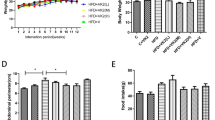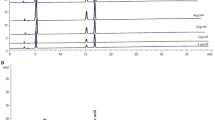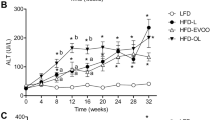Abstract
Objective:
Fatty liver disease is commonly associated with obesity, insulin resistance and diabetes. Severe fatty liver is sometimes accompanied by steatohepatitis and may lead to the development of hepatocellular carcinoma. At present, there is no effective treatment for non-alcoholic fatty liver disease (NAFLD); thus, recent investigations have focused on developing effective therapeutics to treat this condition. This study aimed to evaluate the effects of kefir on the hepatic lipid metabolism of ob/ob mice, which are commonly used to model fatty liver disease.
Results:
In this study, we used leptin receptor-deficient ob/ob mice as an animal disease model of NAFLD. Six-week-old ob/ob mice were orally administered the dairy product kefir (140 mg kg–1 of body weight (BW) per day) for 4 weeks. The data demonstrated that kefir improved fatty liver syndrome on BW, energy expenditure and basal metabolic rate by inhibiting serum glutamate oxaloacetate transaminase (GOT) and glutamate pyruvate transaminase (GPT) activities (P<0.05) and by decreasing the triglyceride (TG) and total cholesterol (TC) contents of the liver (P<0.05). Oral kefir administration also significantly reduced the macrovesicular fat quantity in liver tissue. In addition, kefir markedly decreased the expression of the genes sterol regulatory element-binding protein 1 (SREBP1), fatty acid synthase (FAS) and acetyl-CoA carboxylase (ACC) (P<0.05) but not the expression of peroxisome proliferator-activated receptor α (PPARα) or hepatic carnitine palmitoyltransferase-1α (CPT1α) in the livers of ob/ob mice.
Conclusion:
On the basis of these results, we conclude that kefir improves NAFLD on BW, energy expenditure and basal metabolic rate by inhibiting the lipogenesis pathway and that kefir may have the potential for clinical application to the prevention or treatment of NAFLD.
This is a preview of subscription content, access via your institution
Access options
Subscribe to this journal
Receive 12 print issues and online access
$259.00 per year
only $21.58 per issue
Buy this article
- Purchase on Springer Link
- Instant access to full article PDF
Prices may be subject to local taxes which are calculated during checkout





Similar content being viewed by others
References
Popkin BM, Doak CM . The obesity epidemic is a worldwide phenomenon. Nutr Rev 1998; 56: 106–114.
Racette SB, Deusinger SS, Deusinger RH . Obesity: overview of prevalence, etiology, and treatment. Phys Ther 2003; 83: 276–288.
Steppan CM, Bailey ST, Bhat S, Brown EJ, Banerjee RR, Wright CM et al. The hormone resistin links obesity to diabetes. Nature 2001; 409: 307–312.
Calle EE, Kaaks R . Overweight, obesity and cancer: epidemiological evidence and proposed mechanisms. Nat Rev Cancer 2004; 4: 579–591.
St-Onge MP, Farnworth ER, Savard T, Chabot D, Mafu A, Jones PJ . Kefir consumption does not alter plasma lipid levels or cholesterol fractional synthesis rates relative to milk in hyperlipidemic men: a randomized controlled trial. BMC Complement Altern Med 2002; 2: 1–7.
Farnworth ER, Mainville I . Kefir: a fermented milk product. In: Farnworth ER (ed). Handbook of Fermented Functional Foods. CRC Press: Boca Raton, FL, 2003. pp 77–112.
Vujicic IF, Vulic M, Konyves T . Assimilation of cholesterol in milk by kefir cultures. Biotechnol Lett 1992; 14: 847–850.
Lin CW, Chen HL, Liu JR . Identification and characterization of lactic acid bacteria and yeasts isolated from kefir grains in Taiwan. Aust J Dairy Technol 1999; 54: 14–18.
Yen CC, Lin CY, Chong KY, Tsai TC, Shen CJ, Lin MF et al. Lactoferrin as a natural regimen of selective decontamination of the digestive tract: recombinant porcine lactoferrin expressed in the milk of transgenic mice protects neonates from pathogen challenges in the gastrointestinal tract. J Infect Dis 2009; 199: 590–598.
Chen HL, Wang LC, Chang CH, Yen CC, Cheng WT, Wu SC et al. Recombinant porcine lactoferrin expressed in the milk of transgenic mice protects neonatal mice from a lethal challenge with enterovirus type 71. Vaccine 2008; 26: 891–898.
Chen YJ, Wu CY, Chang CC, Ma CJ, Li MC, Chen CM . Nuclear Kruppel-like factor 4 expression is associated with human skin squamous cell carcinoma progression and metastasis. Cancer Biol Ther 2008; 7: 777–782.
Tung YT, Chen HL, Yen CC, Lee PY, Tsai HC, Lin MF et al. Bovine lactoferrin inhibits lung cancer growth through suppression of both inflammation and expression of vascular endothelial growth factor. J Dairy Sci 2013; 96: 2095–2106.
Chen JY, Chen HL, Cheng JC, Lin HJ, Tung YT, Lin CF et al. A Chinese herbal medicine, Gexia-Zhuyu Tang (GZT), prevents dimethylnitrosamine-induced liver fibrosis through inhibition of hepatic stellate cells proliferation. J Ethnopharmacol 2012; 142: 811–818.
Chen HL, Lai YW, Chen CS, Chu TW, Lin W, Yen CC et al. Probiotic Lactobacillus casei expressing human lactoferrin elevates antibacterial activity in the gastrointestinal tract. Biometals 2010; 23: 543–554.
Tsai TC, Lin W, Yan SH, Cheng WT, Cheng EH, Lee MS et al. Granzyme G is expressed in the two-cell stage mouse embryo and is required for the maternal-zygotic transition. BMC Dev Biol 2010; 10: 88.
Chen CM, Chen HL, Hsiau TH, Hsiau AH, Shi H, Brock GJ et al. Methylation target array for rapid analysis of CpG island hypermethylation in multiple tissue genomes. Am J Pathol 2003; 163: 37–45.
Chen YJ, Wu CY, Shen JL, Chu SY, Chen CK, Chang YT et al. Psoriasis independently associated with hyperleptinemia contributing to metabolic syndrome. Arch Dermatol 2008; 144: 1571–1575.
Yen CC, Lai YW, Chen HL, Lai CW, Lin CY, Chen W et al. Aerosolized human extracellular superoxide dismutase prevents hyperoxia-induced lung injury. PLoS One 2011; 6: e26870.
Tung YT, Chen HL, Lai CW, Shen CJ, Lai YW, Chen CM . Curcumin reduces pulmonary tumorigenesis in vascular endothelial growth factor (VEGF)- overexpressing transgenic mice. Mol Nutr Food Res 2011; 55: 1036–1043.
Wu SC, Chen HL, Yen CC, Kuo MF, Yang TS, Wang SR et al. Recombinant porcine lactoferrin expressed in the milk of transgenic mice enhances offspring growth performance. J Agri Food Chem 2007; 55: 4670–4677.
Ho JN, Choi JW, Lim WC, Kim MK, Lee IY, Cho HY . Kefir inhibits 3T3-L1 adipocyte differentiation through down-regulation of adipogenic transcription factor expression. J Sci Food Agric 2013; 93: 485–490.
Foufelle F, Ferre P . New perspectives in the regulation of hepatic glycolytic and lipogenic genes by insulin and glucose: a role for the transcription factor sterol regulatory element binding protein-1c. Biochem J 2002; 366: 377–391.
Andreolas C, da Silva Xavier G, Diraison F, Zhao C, Varadi A, Lopez-Casillas F et al. Stimulation of acetyl-CoA carboxylase gene expression by glucose requires insulin release and sterol regulatory element binding protein 1c in pancreatic MIN6 beta-cells. Diabetes 2002; 51: 2536–2545.
Kajita K, Ishizuka T, Mune T, Miura A, Ishizawa M, Kanoh Y et al. Dehydroepiandrosterone down-regulates the expression of peroxisome proliferator-activated receptor gamma in adipocytes. Endocrinology 2003; 144: 253–259.
Latasa MJ, Griffin MJ, Moon YS, Kang C, Sul HS . Occupancy and function of the 150 sterol regulatory element and 65 E-box in nutritional regulation of the fatty acid synthase gene in living animals. Mol Cell Biol 2003; 23: 5896–5907.
Horton JD, Bashmakov Y, Shimomura I, Shimano H . Regulation of sterol regulatory element binding proteins in livers of fasted and refed mice. Proc Natl Acad Sci USA 1998; 95: 5987–5992.
Guzel-Seydim ZB, Kok-Tas T, Greene AK, Seydim AC . Review: functional properties of kefir. Crit Rev Food Sci Nutr 2011; 51: 261–268.
de Moreno de Leblanc A, Matar C, Farnworth E, Perdigón G . Study of immune cells involved in the antitumor effect of kefir in a murine breast cancer model. J Dairy Sci 2007; 90: 1920–1928.
Hertzler SR, Clancy SM . Kefir improves lactose digestion and tolerance in adults with lactose maldigestion. J Am Diet Assoc 2003; 103: 582–587.
Vinderola G, Perdigón G, Duarte J, Farnworth E, Matar C . Effects of the oral administration of the products derived from milk fermentation by kefir microflora on immune stimulation. J Dairy Res 2006; 73: 472–479.
Güven A, Güven A, Gülmez M . The effect of kefir on the activities of GSH-Px, GST, CAT, GSH and LPO levels in carbon tetrachloride-induced mice tissues. J Vet Med B 2003; 50: 412–416.
Kiessling G, Schneider J, Jahreis G . Long-term consumption of fermented dairy products over 6 months increases HDL cholesterol. Eur J Clin Nutr 2002; 56: 843–849.
Acknowledgements
We thank the Taiwan Mouse Clinic (NSC 102-2325-B-001-042), which is funded by the National Research Program for Biopharmaceuticals (NRPB) at the National Science Council (NSC) of Taiwan, for their technical support in assessing the body composition and the TSE experiments. This research was supported in part by grants NSC-101-2313-B-212-001-MY2 and NSC-100-2313-B-005-028-MY3 from the National Science Council and the Ministry of Education, Taiwan, Republic of China, under the Aiming for the Top University (ATU) plan.
Author information
Authors and Affiliations
Corresponding author
Ethics declarations
Competing interests
The authors declare no conflict of interest.
Additional information
Supplementary Information accompanies this paper on International Journal of Obesity website
Rights and permissions
About this article
Cite this article
Chen, HL., Tung, YT., Tsai, CL. et al. Kefir improves fatty liver syndrome by inhibiting the lipogenesis pathway in leptin-deficient ob/ob knockout mice. Int J Obes 38, 1172–1179 (2014). https://doi.org/10.1038/ijo.2013.236
Received:
Revised:
Accepted:
Published:
Issue Date:
DOI: https://doi.org/10.1038/ijo.2013.236
Keywords
This article is cited by
-
Kefir in the Prevention and Treatment of Obesity and Metabolic Disorders
Current Nutrition Reports (2020)
-
Kefir peptides alleviate particulate matter <4 μm (PM4.0)-induced pulmonary inflammation by inhibiting the NF-κB pathway using luciferase transgenic mice
Scientific Reports (2019)
-
Beneficial effects of cocoa, coffee, green tea, and garcinia complex supplement on diet induced obesity in rats
BMC Complementary and Alternative Medicine (2016)
-
Kefir peptides prevent high-fructose corn syrup-induced non-alcoholic fatty liver disease in a murine model by modulation of inflammation and the JAK2 signaling pathway
Nutrition & Diabetes (2016)
-
Using Dual Fluorescence Reporting Genes to Establish an In Vivo Imaging Model of Orthotopic Lung Adenocarcinoma in Mice
Molecular Imaging and Biology (2016)



